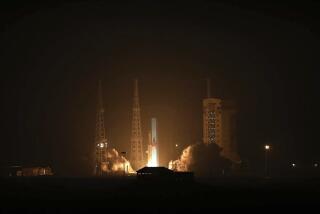Taking friendly fire to new heights
Last night, three Navy warships waited in the Pacific for orders to shoot down a crippled U.S. spy satellite, using weapons designed for missile defense. The Bush administration said the goal was to prevent the satellite’s 1,000 gallons of toxic fuel from falling on populated areas. But at about 7:30 p.m, when the order came, the administration put at risk multiple U.S. security interests -- a high price to pay to offset that highly unlikely danger.
The administration has insisted that it was not trying to test the anti-satellite capabilities of the Navy’s Aegis missile defense system, but that was exactly the result. The action was similar to China’s unwise anti-satellite test in January 2007: An interceptor missile was launched, releasing a warhead meant to destroy the target satellite.
Unlike China, the U.S. had announced this launch in advance. And the explosion was not expected to produce nearly as much dangerous debris in near-Earth space. But these are pale distinctions -- ones that American allies and others may find unpersuasive. Just as China did, the U.S. was demonstrating its anti-satellite capability, stepping briefly across a dangerous threshold, undercutting American and international criticism of China and threatening an arms race in space.
Capabilities count as much as intentions. The U.S. could deploy this new anti-satellite capability on 18 ships. And not just American warships. After protracted effort, the U.S. persuaded Japan to acquire Aegis destroyers to defend against North Korean missiles. Japan will now discover that with little more than software changes, its planned four Aegis-equipped ships could become satellite killers. This will be highly unpopular in Japan, given the nation’s historically strong stand against space weapons. The potential threat to Chinese satellites will surely aggravate always fragile Chinese-Japanese relations as well.
Washington should not be surprised when Beijing exploits this launch to justify its own burgeoning anti-satellite program. The U.S. action will give China, Russia and others an excuse to develop and test comparable capabilities, claiming that they too need to keep their populations safe from falling satellites. China may well feel freed from the pledge it made last year not to test its anti-satellite weapons again.
How would Americans feel if the situation were reversed, and China blew up a crippled satellite even though the risk of casualties from satellite reentry was small? To ask the question is to answer it: The United States would look beyond the given rationale, focus on the demonstrated capability and respond.
These security costs would have been compounded had the U.S. launch failed. That would have reduced the Aegis system’s credibility and could have led Japan to wonder if it had bought a multibillion-dollar problem.
All this could have been justified were there a significant risk to life from this satellite’s reentry into the atmosphere. But the risk was small. No one has ever been killed or seriously injured from satellite reentry. When the White House announced the satellite’s condition last month, it said there was little risk to people.
Given the potential damage to U.S. security interests, and the $40-million to $60-million cost of shooting the satellite down, some suspect an unspoken agenda here that goes beyond any concern about casualties. We are agnostic on that, but this money could surely have saved many more lives if it had been spent elsewhere, without the security downside and the diplomatic fallout.
Bruce W. MacDonald, former assistant director for national security in the White House science advisor’s office, is writing a special report on China and military space for the Council on Foreign Relations. Charles D. Ferguson is a council fellow for science and technology.
More to Read
Sign up for Essential California
The most important California stories and recommendations in your inbox every morning.
You may occasionally receive promotional content from the Los Angeles Times.










